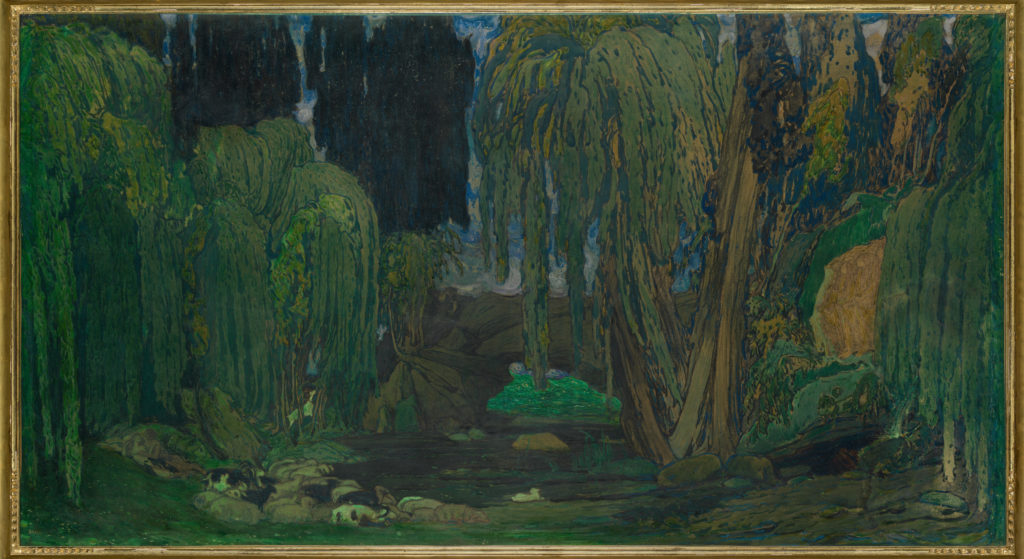Narcisse: Dance, design and a dodgy daffodil
“I recall the opening scene, a green forest glade of tall willows and beeches, joined by a rocky bridge, and in the distance the red glow of the rising sun. In the semi-darkness a strange band of wood-sprites with olive green bodies and large pointed ears emerged from the shadows…”
Sounds a bit like J. R. R. Tolkien? Maybe Enid Blyton? How about Ovid? You might not think of pointy-eared sprites as especially Grecian, but in 1911 it was Fokine’s ballet Narcisse, based on the legend found in Ovid’s Metamorphoses, that seduced audiences with a fantastical cast of sylvan inhabitants and merry-making, goblet-waving bacchantes.
Narcisse is a ballet remembered today almost exclusively on account of its stunning, sensual designs by Russian artist Leon Bakst (1866-1924). It was one of three extraordinary Grecian ballets that Bakst designed for Diaghilev’s Ballets Russes, each of which – as it happens – is now best remembered for one particular element of its production. Daphnis et Chloe (1912), for example, is widely celebrated for its evocative music by Maurice Ravel, while L’après-midi d’un faune (1912) for its shocking, sexually suggestive choreography by Vaslav Nijinsky, while Narcisse lives on though its visceral series of costumes designs, in which Bakst’ fabrics and figures wreate together in a riot of vibrant exoticism.
The haste with which Narcisse was conceived explains in part why neither Fokine’s choreography, nor the score by Nikolai Tcherepnin, proved memorable additions to the creative legacy of the Ballets Russes. Despite the all-star cast that brought the work to life – no less than Vaslav Nijinsky, his sister Bronislava Nijinska and Tamara Karsavina – Narcisse was foist upon Fokine by an insistent Diaghilev, grown impatient with Ravel’s slow progress on score for Daphnis et Chloe. Fokine, who was choreographing Daphnis et Chloe, was instructed to produce Narcisse in the meantime, and it was Diaghilev himself who chose the mythological subject matter of the new ballet.
Perhaps as a result of its pressured gestation, the ballet that premièred on 8 June 1911 lacked the flair and careful detailing of Fokine’s more successful works. As the youthful Narcissus, Nijinsky may have appeared resplendent in “a fair Grecian wig, a white chlamys with one bare shoulder” and “sandals with the legs cross-gartered”, but Cyril Beaumont could later recall “nothing of his dancing”. What lingered in Beaumont’s mind were individual poses, specific gestures that these charismatic dancers imbued with meaning.
He remembered Nijinska as the Bacchante in “a wig of flowing red hair and classic robe coloured red and blue”, who danced holding a “beaker of wine in one hand and a wine-cup in the other” and later with a scarf “which she held extended between her raised hands, or allowed to curl gracefully into the air.” He recalled Karsavina’s “inimitable gesture, which alone made the ballet worth while”, burying her face in the crook of her arm in a “moving demonstration of her grief when Narcissus disdained her love.”
And Beaumont certainly remembered the electrifying moment when Nijinsky, “crouched down by the edge of the pool … gazed spell-bound at his own image, bending down with infinite grace closer and closer to the surface of the water, until he disappeared beneath its surface, while in his stead rose a single narcissus flower.” The dancer’s extraordinary stage presence rendered the moment almost perfect…
Almost, but for that flower. Thanks to Diaghilev’s choice of subject matter, Fokine and his collaborators faced one very large headache in realizing Nijinsky’s transformation. As Beaumont wrote, “The one blemish on Diaghilev’s artistic reputation is that he should ever have sanctioned that blatantly false bloom, perched on the end of a stick which wobbled so clumsily as it was pushed into view from below.”
The ballet may have been “pleasing”, even “very delicate and beautiful” according to dancers’ fellow ballerina Lydia Sokolova. But the work received a mixed response in Paris, nor was its reception in London and Monte Carlo sufficient to secure its permanent place in the repertoire. Only a handful of photographs attests to the ballet’s existence. Bakst’s images, however, continue to enchant with their brilliant colouring and evocation of ecstatic revelry.


Leave a Reply